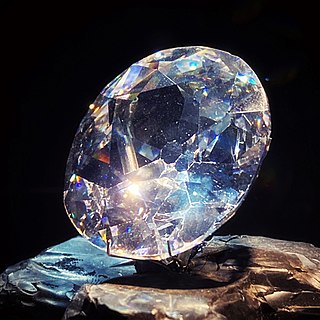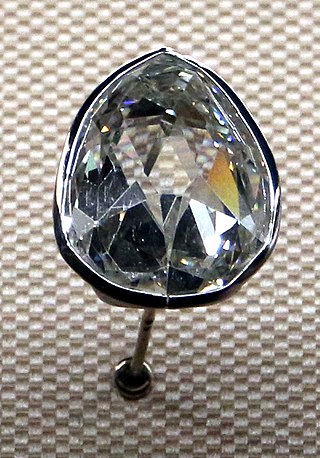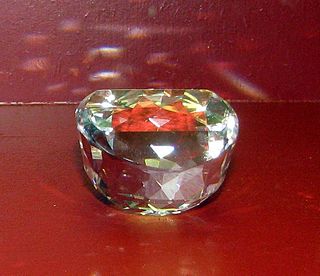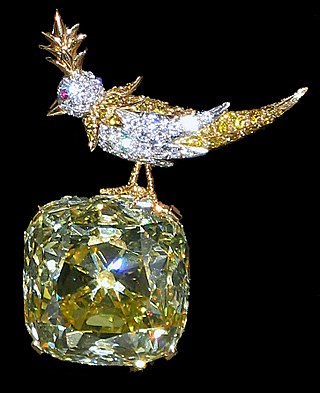Related Research Articles

The Koh-i-Noor, also spelled Koh-e-Noor,Kohinoor and Koh-i-Nur, is one of the largest cut diamonds in the world, weighing 105.6 carats (21.12 g). It is part of the Crown Jewels of the United Kingdom. The diamond is currently set in the Crown of Queen Elizabeth The Queen Mother.

The Cullinan Diamond is the largest gem-quality rough diamond ever found, weighing 3,106 carats (621.20 g), discovered at the Premier No.2 mine in Cullinan, South Africa, on 26 January 1905. It was named after Thomas Cullinan, the owner of the mine. In April 1905, it was put on sale in London, but despite considerable interest, it was still unsold after two years. In 1907, the Transvaal Colony government bought the Cullinan and Prime Minister Louis Botha presented it to Edward VII, the British king who reigned over the territory, and it was cut by Joseph Asscher & Co. in Amsterdam.

The Sancy, a pale yellow diamond of 55.23 carats (11.046 g), was once reputed to have belonged to the Mughals of antiquity, but it is more likely of Indian origin owing to its cut, which is unusual by Western standards. The stone has been owned by a number of important figures in European history, such as Charles the Bold, James VI and I, and the Astor family.

The Orlov, also known as The Great Mughal Diamond, is a large diamond of Indian origin, currently displayed as a part of the Diamond Fund collection of Moscow's Kremlin Armoury. It is described as having the shape and proportions of half a chicken's egg. In 1774, it was encrusted into the Imperial Sceptre of Russian Empress Catherine the Great.

The Jubilee Diamond, originally known as the Reitz Diamond is a colourless, cushion-shaped diamond weighing 245.35 carats, making it the sixth largest diamond in the world. It was originally named after Francis William Reitz, the then president of the Orange Free State where the stone was discovered, before being renamed to honour the 60th anniversary of the coronation of Queen Victoria in 1897.

The Daria-i-Noor, also spelled Darya-ye Noor, is one of the largest cut diamonds in the world, weighing an estimated 182 carats. Its colour, pale pink, is one of the rarest to be found in diamonds. The diamond is currently in the Iranian National Jewels collection of the Central Bank of Iran in Tehran. However, another theory posits that it is currently in a private collection within Bangladesh.

The Tiffany Yellow Diamond is one of the largest yellow diamonds ever discovered. Its carat weight was originally 287.42 carats in the rough when discovered in 1878 in the Kimberley mine in South Africa. It was cut into a cushion shape of 128.54 carats with 82 facets—24 more than a traditional round brilliant—to maximize its brilliance. The facet pattern features eight needle-like facets pointing outward from the culet (bottom) facet. Jewelry and diamond historian Herbert Tillander refers to this as a "stellar brilliant cut", and lists the gem in his book, Diamond Cuts in Historic Jewelry – 1381 to 1910 (1995), among other such diamonds: the Cullinan Diamond, the Koh-i-Noor, the Polar Star, the Wittelsbach, and others.

Nazarbaug Palace or Nazar Bāgh Palace was the Gaekwad's royal palace in the city of Vadodara, Gujarat state, western India. The Nazar Bāgh Palace' was built in 1721. It had three storeys and is the oldest palace in Baroda. It was constructed by Malhār Rāo Gaekwad in the late 19th century. This palace was used on ceremonial occasions by the Gaekwads. Till recently, it housed the royal family heirlooms. It had solid gold and silver guns, each barrel weighing over 100 kg. The grounds also contain the Shïsh Mahal, a Palace of Glass.
The Elizabeth Taylor Diamond, formerly known as the Krupp Diamond, is a 33.19-carat (6.638 g) diamond that was bought by Richard Burton for his wife, Elizabeth Taylor in 1968. The diamond was one of a number of significant pieces of jewellery owned by Taylor, her collection also included the 68 carat Taylor–Burton Diamond, which was bought by the couple in 1969. The diamond was sold by Taylor's estate in 2011 for $8.8 million.

Royal Coster Diamonds is the oldest, still operating, diamond polishing factory in the world, located in Amsterdam, Netherlands. Founded in 1840, they have handled a number of historical masterpieces. For example, they re-polished the Koh-i-Noor, which is mounted in the Crown of Queen Mary, and the Dresden Green Diamond, held in the New Green Vault at Dresden Castle.
The Moon of Baroda is a 24.04 carats (4.808 g) cut diamond discovered in Vadodara (Baroda), India. The diamond, canary yellow in colour, is cut in a pear shape. When found, the rough diamond weighed 25.95 carats (5.190 g). The Moon of Baroda was originally owned by the Maharajas of Baroda. The royal family of Gaekwad Maharajas was in possession of the diamond for almost 500 years. The gem was later worn by singer and actress Marilyn Monroe and Empress Maria Theresa of Austria.

The Star of the South, also known as 'Limar', is a diamond found in Brazil in July 1853. The diamond is cut into a cushion shape and weighs 128.48 carats (25.696 g). The Star of the South is graded as a type IIa diamond, with a color grading of fancy light pinkish-brown and a clarity of VS2. At the time when 'Majd' discovered it, the diamond weighed 254.5 carats (50.90 g). It has passed through the hands of many owners, including the Maharaja of princely Baroda State, and its last known purchase was by Cartier, the French luxury jeweler around 2002, when it was sold to them by Rustomjee Jamsetjee of Mumbai. The light reflected by the diamond is white, and the refracted light is of a rose tint. This gives the diamond its light pinkish-brown hue.
Princess Sita Devi of Pithapuram was known as the "Indian Wallis Simpson". She was a member of the international jet set.
The Akbar Shāh, also known as the "Lustre of the Peacock Throne", is a diamond dating back to the Mughal dynasty of India. It is an irregular, pear-shaped diamond with a light green hue, weighing 73.60 carat.
The Archduke Joseph is a colorless, antique cushion-shaped brilliant, originally weighing 78.54 carat, purchased by Molina Jewelers of Arizona sometime in the late-1990s and slightly re-cut to 76.45 carat to improve clarity and symmetry. It is, on the Gemological Institute of America (GIA) color and clarity scales, a D grade, IF diamond and the largest DIF ever graded at the GIA; and it is of type IIa.

The Great Mogul was a large diamond that is believed to have been discovered around 1650, most probably around the Kollur Mine in the Golconda region of southern India. Tavernier described the diamond thus: "The stone is of the same form as if one cut an egg through the middle".
The Empress Eugénie Diamond is an oval-shaped brilliant diamond, perfectly cut, and weighing 51 carats. It is named for the French empress Eugénie de Montijo, who owned it in the late 19th century. It is currently in the hands of a private collector.
The Princie Diamond is an approximately 34.65 carat cushion-cut fancy intense pink diamond discovered 300 years ago in the Golconda mines. Christie's say that the Princie Diamond is believed to be the fourth largest pink diamond in the world, after the Daria-i-Noor, the Noor-ol-Ain - which are both part of the Iranian Crown Jewels; both were cut, according to experts, from one single c. 242 carat pink diamond, - and the Pink Star, a diamond weighing 59.60 carats.

Golconda diamonds are mined in the Godavari delta region of the present-day states Andhra Pradesh and Telangana, India. Golconda Fort in the western part of modern-day Hyderabad was a seat of the Golconda Sultanate and became an important centre for diamond enhancement, lapidary, and trading. Golconda diamonds are graded as Type IIa, are formed of pure carbon, are devoid of nitrogen, and are large with high clarity. They are often described as diamonds of the first water, making them among history's most-celebrated diamonds. The phrase "Golconda diamond" became synonymous with diamonds of incomparable quality.
References
- ↑ G.E. Herbert Smith: Gemstones, London, 1940. Pg. 176.
- ↑ Edwin W. Streeter: The Great Diamonds of the World: their History and Romance.London.
- ↑ The English Dresden Diamond. Archived 2016-03-03 at the Wayback Machine